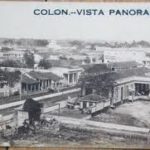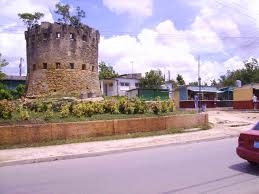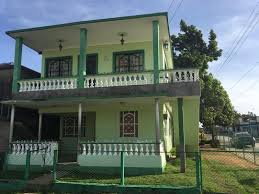

 COLON CITY, MATANZAS, CUBA. EMBLEMATIC FOR ITS PAST ARCHITECTURAL STYLE BUILDINGS. COLOMBINOS.
COLON CITY, MATANZAS, CUBA. EMBLEMATIC FOR ITS PAST ARCHITECTURAL STYLE BUILDINGS. COLOMBINOS.
Colón is a municipality and city in the Matanzas Province of Cuba. The municipality has an area of 547 km2 and a population of about 71,000. The city proper, with a population of about 44,000, is the third-largest one of its province.
HISTORY
The town was founded in 1836 under the name Nueva Bermeja. The railroad, arrived nearby the town still in 1843, reached it in 1851. In 1852, Fernando Diago, the owner of the sugar-mill Ponina, inaugurates the first public school in town. In 1859, it achieved the status of the villa (town) with the name Colón, after Christopher Columbus (Cristóbal Colón in Spanish). The founder’s name is don Martín José Zozaya, who founded the town in the former hacienda named La Bermeja. The deed to establish this town was signed in the city of Matanzas in 1836. At the time, don Martín set apart land for a cemetery and a church.
Until the 1977 administrative reform, the municipality was divided into the campos of Agüica, Este, Guareiras, Jacán, Laguna Grande, Oeste and Palmillas.
GEOGRAPHICS
Colón borders with the municipalities of Corralillo (in Villa Clara Province), Los Arabos, Calimete, Jagüey Grande, Perico and Martí. Its territory includes the villages of Agüica, Banaguises, Guareiras, La Panchita, México, René Fraga, Río Piedras, San José de los Ramos, Santa Gertrudis, Segio González and other minor rural localities.
DEMOGRAPHICS
In 2004, the municipality of Colón had a population of 71,579. With a total area of 597 km2 (231 sq mi), it has a population density of 119.9/km2 (311/sq mi).
ARCHITECTURE
The city of Colón, since its founding, has gone through different architectural styles, some of them on specific buildings and others that were emblematic in different stages, but left a very strong imprint that identifies this villa and ranging from Neoclassicism, through the Balloon Frame, Eclectic, Art Nouveau, Art Deco, until rationalism. It can be seen in its streets, well marked and different styles of its buildings. The peak of neoclassicism can be admired in the Catholic temple founded December 8, 1872, and the Town Hall. In the late 1880s, as atypical and off-note of the layout of the town, was built the Quinta de Tirso Mesa, an irrefutable example of the introduction of Balloon Frame and the phenomenon of acculturation in our architecture. Now This building is gone, but it has left a mark on the population still remembered for its beauty.
The introduction of eclectic Columbian architecture was made with the construction of the School of Arts and Crafts, built between October 16, 1911, and November 28, 1912. While not renouncing some neoclassical codes, in this style can be mentioned other constructions such as Ferrolana, Provincial Agricultural College (now Polytechnic Institute of Health Mario Muñoz), etc. The period 1930-1959 meant a lot to the city for two main reasons: the opening in 1930 of the section of the Carretera Central highway between Havana and Santa Clara, and the rise to the mayor of José Manuel Gutiérrez Plans (1927 – 1933), under whose mandate several notable buildings appeared, such as the New Continental Hotel (1937), resulting in a new architectural style in the city, Art Deco, with the Canal Theatre as its finest example. Between 1948 and 1959, rationalism makes its entrance into the city, and the best examples can be seen in the Santiago-Havana and Grand Charity hotels.
ECONOMY
Colón’s economy is centered around agriculture (sugarcane, tobacco, citrus fruit, honey) and stock raising. It is also an important railway center.
NOTABLE PEOPLE
Paul Casanova (1941–2017), baseball player; José Miguel Fernández (b. 1988), baseball player; Oscar Nunez (b. 1958), Cuban-American actor and comedian; Mario Quintero (1924–2017), basketball player; Félix Ramos y Duarte (1848–1924), educator and writer.
 CIUDAD DE COLON, MATANZAS, CUBA. EMBLEMÁTICO POR EL PASADO ARQUITECTÓNICO DE SUS EDIFICIOS. COLOMBINOS.
CIUDAD DE COLON, MATANZAS, CUBA. EMBLEMÁTICO POR EL PASADO ARQUITECTÓNICO DE SUS EDIFICIOS. COLOMBINOS.
Colón es un municipio y ciudad de la provincia de Matanzas en Cuba. El municipio tiene una superficie de 547 km2 y una población de alrededor de 71.000. La ciudad propiamente dicha, con una población de aproximadamente 44.000 habitantes, es la tercera más grande de su provincia.
HISTORIA
La localidad fue fundada en 1836 con el nombre de Nueva Bermeja. El ferrocarril, arribado cerca de la ciudad todavía en 1843, lo alcanzó en 1851. En 1852, Fernando Diago, dueño del ingenio Ponina, inaugura la primera escuela pública de la ciudad. En 1859, alcanzó el estatus de villa (pueblo) con el nombre de Colón, en honor a Cristóbal Colón (Cristóbal Colón en español). El nombre del fundador es don Martín José Zozaya, quien fundó el pueblo en la antigua hacienda llamada La Bermeja. La escritura de constitución de esta villa se firmó en la ciudad de Matanzas en 1836. En ese momento don Martín destinó un terreno para un cementerio y una iglesia.
Hasta la reforma administrativa de 1977, el municipio estaba dividido en los campos de Agüica, Este, Guareiras, Jacán, Laguna Grande, Oeste y Palmillas.
GEOGRAFÍA
Colón limita con los municipios de Corralillo (en la provincia de Villa Clara), Los Arabos, Calimete, Jagüey Grande, Perico y Martí. Su territorio incluye los pueblos de Agüica, Banaguises, Guareiras, La Panchita, México, René Fraga, Río Piedras, San José de los Ramos, Santa Gertrudis, Segio González y otras localidades rurales menores.
DEMOGRAFÍA
En 2004, el municipio de Colón tenía una población de 71.579. Con un área total de 597 km2 (231 millas cuadradas), tiene una densidad de población de 119,9 / km2 (311 millas cuadradas).
ARQUITECTURA
La ciudad de Colón, desde su fundación, ha pasado por diferentes estilos arquitectónicos, algunos de ellos en edificaciones puntuales y otros que fueron emblemáticos en distintas etapas, pero dejaron una huella muy fuerte que identifica a esta villa y que van desde el neoclasicismo, pasando por el Marco del Globo. , Ecléctico, Art Nouveau, Art Deco, hasta el racionalismo. Se puede ver en sus calles, bien señalizadas y con diferentes estilos de sus edificios. El apogeo del neoclasicismo se puede admirar en el templo católico fundado el 8 de diciembre de 1872 y en el Ayuntamiento. A finales de la década de 1880, como atípico y fuera de lugar del trazado del pueblo, se construyó la Quinta de Tirso Mesa, un ejemplo irrefutable de la introducción de Balloon Frame y el fenómeno de la aculturación en nuestra arquitectura. Ahora este edificio ha desaparecido, pero ha dejado una huella en la población que aún es recordada por su belleza.
La implantación de la arquitectura ecléctica colombiana se hizo con la construcción de la Escuela de Artes y Oficios, construida entre el 16 de octubre de 1911 y el 28 de noviembre de 1912. Sin renunciar a algunos códigos neoclásicos, en este estilo se pueden citar otras construcciones como Ferrolana. , Colegio Provincial Agropecuario (ahora Instituto Politécnico de Salud Mario Muñoz), etc. El período 1930-1959 significó mucho para la ciudad por dos motivos principales: la apertura en 1930 del tramo de la Carretera Central entre La Habana y Santa Clara, y el ascenso a la alcaldía de José Manuel Gutiérrez Planos (1927 – 1933), bajo cuyo mandato aparecieron varios edificios notables, como el Nuevo Hotel Continental (1937), dando como resultado un nuevo estilo arquitectónico en la ciudad, el Art Deco, con la Canal Theatre como su mejor ejemplo. Entre 1948 y 1959, el racionalismo hace su entrada en la ciudad, y los mejores ejemplos se pueden ver en los hoteles Santiago-La Habana y Grand Charity.
ECONOMÍA
La economía de Colón se centra en la agricultura (caña de azúcar, tabaco, cítricos, miel) y la ganadería. También es un importante centro ferroviario.
GENTE NOTABLE
Paul Casanova (1941-2017), jugador de béisbol; José Miguel Fernández (n. 1988), jugador de béisbol; Oscar Nunez (n. 1958), actor y comediante cubanoamericano; Mario Quintero (1924-2017), jugador de baloncesto; Félix Ramos y Duarte (1848-1924), educador y escritor.
Agencies/ Wiki/ Internet Photos/ Arnoldo Varona/ www.TheCubanHistory.com
THE CUBAN HISTORY, HOLLYWOOD.



 COLÓN City, Matanzas, Cuba, emblematic for its Past Architectural style Building. Colombinos.* CIUDAD de Colón, Matanzas, Cuba. Emblemático por el Pasado Arquitectonico de sus Edificios. Colombinos. PHOTOS.
COLÓN City, Matanzas, Cuba, emblematic for its Past Architectural style Building. Colombinos.* CIUDAD de Colón, Matanzas, Cuba. Emblemático por el Pasado Arquitectonico de sus Edificios. Colombinos. PHOTOS.








